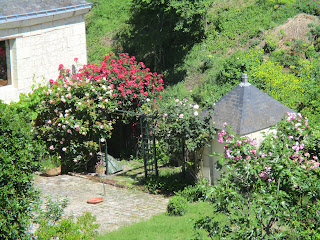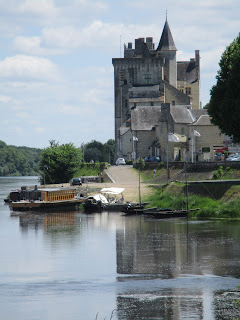Montsoreau is a small town, a beautiful village, in fact, rising up on the banks of the Loire River. In fact, the river used to come right up to the walls of the château.
 |
| Chateau de Montsoreau - the Loire River on the right used to come up to the château |
The town of Montsoreau is worthy a visit under any circumstances.
 |
| someone's back yard |
 |
| flowers growing along the roadside |
 |
| looking out from the château to the town |
 |
| troglodyte residence |
 |
| another troglodyte residence |
Stone buildings sport wild flowers and roses growing out of cracks and crevices.
Views of the Loire River below peek from between buildings.
A lovely picnic area along the Loire provided only partial shade on a hot day and brushy trees blocked a view of the Loire, but it was a welcome rest stop complete with bathrooms, so no complaints.
We discovered a local sport via a sign and peering through the windows of a community center. Called Boule de Fort, this game is played like typical boules (also called pétanque, or Bocci, if you're Italian) - players throw balls (boules) toward a smaller ball (called a cochennet) with the boule closest to the cochennet winning the point. Ten points wins the game. But there are twists in this very angevine game, played only in this Anjou region. For one, the boules are wooden or plastic balls with a steel band around the middle causing their center of gravity to be off (think zigzagging crazy balls). Then the court is shaped like the shallow hull of a flat-bottomed boat - that is curved gently toward center. We peered in at the court through the windows of the community center wondering how anyone could steer a ball on a rounded court.
But I digress from the subject of this blog - what to do with a château not suited to restoration. Both Montsoreau and Oiron have used the spaces within their châteaux as art galleries.
Montsoreau's château was a strategic military point at the confluence of the Loire and the Vienne in the 11th century.
Gautier de Montsoreau was the lord who gave land to build the Abbey of Fontevraud. It's present shape owes to a counselor of Charles VII who had the château modernized in 1450. It's a castle that can claim many royal personnages among those who slept here: Louix XI, Anne de Bretagne and her daughter Claude de France and even François I are the notable names.
The Montsoreau name declined in the 17th century when its owner René de Chambes, was convicted of counterfeiting and smuggling salt (?what?) and fled to England to escape death. Oops! After this the château had 19 different owners and was in shambles in the early 20th century. Restoration work was done up to WWII and then again in the 1990s and the château is now a center of modern art with the collection of Phillipe Méaille permanently exhibited.
The theme of the collection is conceptual art and you would have to ask Judy about the meaning of most of the installations. We think the point was to make you explore the personal relationship of viewer to a piece of art, but we were just confused and amused. Walls with 10 small mirrors that reflect the viewer gave perhaps some idea, but is it art?
 |
| mirrors are the art installation in this room |
 |
| the air-conditioner room |
The juxtaposition of the very old castle, rooms empty of furniture and whitewashed walls with ultra-modern art is itself perhaps worthy of discussion. Think how modern and incomprehensible the carvings and architecture of the Renaissance must have been to those coming out of the Middle Ages. Perhaps they also wondered if this was art.
Beyond the art exhibit, we were more comfortable with the architecture of the castle itself. From its ramparts you had sweeping views of the Loire River in both directions as this was the only castle ever built right on the shore of the Loire.
 |
| these lovely fluffy clouds are reflected in the Loire River. (Is this art?) |
 |
| Looking out from the ramparts of the château along the Loire. |
 |
| I like views out old glass windows - probably not art, but I like it |
So now we look at things we don't understand and ask: "Is it conceptual art?" Thanks Montsoreau.
 |
| Is it art? The sun projecting through the château window onto the floor. |
Monday, May 29th was a drizzly morning and we had shopping to do anyway. Janis and Clark had left and Ron and Chris had arrived. We needed some groceries to get us to Thursday market day. And since Haute Perche winery was on the way home and Dave needed to settle an error in last Saturday's wine bill, so we did a bit of wine-tasting on our way home from grocery shopping. Rather unusual to be wine-tasting before noon, but we held ourselves to rosés and whites.
 |
| Ron, Dave, Nancy, Chris and Judy at Haute Perche |
In the afternoon, we headed off to Château d'Oiron, another château that was now being used as an art exhibition space. The château we see today is essentially the 17th century building completed by the Gouffier family who were known as important art collectors. In the 1990s it was decided to install modern art pieces inspired by the family collections (most of which have been scattered to other museums).
 |
| Château d'Oiron |
 |
| school children on their way back to their bus, note the teachers carrying rolls of brown kraft paper - most likely kindergarten aged |
 |
| Ceiling in the Sun Room. The images below are "sun burns" onto painted boards. See description below. |
We found many of these pieces moving, but as many were confusing and amusing. The first room we visited had rose bushes and white domes that looked and hummed like bee hives. On the walls were photos and art reminding of the bombings of WWII and that the sound of the planes was the same sound as the bees we were hearing.
 |
| Bee hives emanating humming noises and rose bushes |
 |
| The hives are named for the aircraft carriers in this battle, some sunk, some damaged. |
We found an amusing baby buggy designed to take one warmly to new places.
The dining room had plates, glasses and napkins hung on the wall, each plate had the profile of a resident of the town of Oiron, the glass had that person's initials and the napkin had the fingerprint of the plate owner. Each year, the dishes are taken down and used in a dinner to which these 150 people are invited.
 |
| The plates hold the profile, the upside down glasses, the initials, and the napkins have the thumbprint of the "owner" on the underside. |
The passageway in front of the dining room had a remarkable optical illusion trick. There were blue curved lines, like of painter's tape, on the walls that made no sense until you looked at a small square in the floor and moved to position yourself such that the lines became circles.
 |
| odd lines on the wall |
 |
| reflected back from a mirror in the floor |
In the paneled reception hall, where one might have expected large oil paintings of ancient family members, there were instead 8 x 10 photos of the town's school children.
 |
| The photos in this gallery are the town's children and the car is an "aero-fiat" |
The Sun Room had a display of 365 Sun Burns - created by using a magnifying glass focused over painted board which then were scarred differently depending on how much sun was available that day. Quite a science experiment actually. (See photo above)
While the others checked out the second floor art, I did my knitting in a lovely covered pavillion with a view to the Courtyard of Honor (the main square in front of this U-shaped palace) and the rest of the château.
 |
| I sat in the pavilion opposite this one that was open on both sides. |
Here, as in other châteaux we've visited, there are several classes touring. This time the children are kindergarten or first grade students and the teachers were holding long rolls of brown paper that were surely part of the lesson plan that day.
 |
| children on their way back to their bus |
So again we've come to the juxtaposition of old and new. This place made more sense to me in its installations, but again, there were many pieces that I looked at and thought Evie and Tristen could have made them just as well. Conceptual art, I guess.
In the end, whatever the verdict on art, the places were memorably beautiful in their settings and prompted us to think about art. So I guess, it all works. And the châteaux continue to provide enjoyment and learning opportunities to new generations.










No comments:
Post a Comment